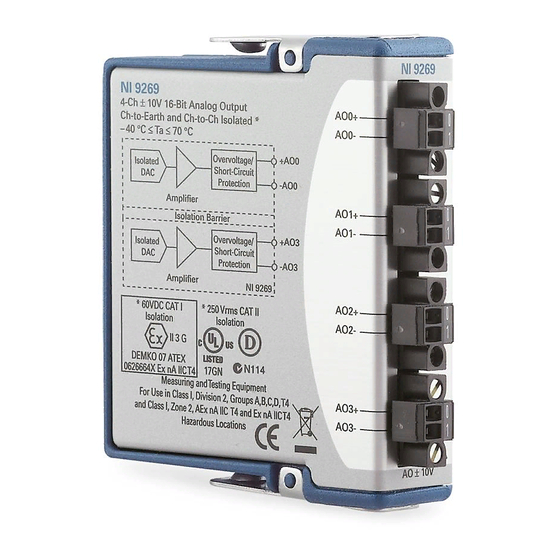Summary of Contents for National Instruments NI 9269
- Page 1 (217) 352-9330 | Click HERE Find the National Instruments NI 9269 at our website:...
- Page 2 GETTING STARTED GUIDE NI 9269 4 AO, ±10 V, ±40 V Stacked, 16 Bit, 100 kS/s/ch Simultaneous hnology Group - Quality Instrumentation ... Guaranteed | (888) 88-SOURCE | www...
-
Page 3: Safety Guidelines
This document explains how to connect to the NI 9269. Before you begin, complete the software and Note hardware installation procedures in your chassis documentation. The guidelines in this document are specific to Note the NI 9269. The other components in the system might not meet the same safety ratings. -
Page 4: Safety Guidelines For Hazardous Voltages
You must use the NI 9971 connector backshell kit to ensure that the terminals are not accessible. NI 9269 Getting Started Guide | © National Instruments | 3 hnology Group - Quality Instrumentation ... Guaranteed | (888) 88-SOURCE | www... -
Page 5: Safety Voltages
MAINS voltage. MAINS is a hazardous live 4 | ni.com | NI 9269 Getting Started Guide hnology Group - Quality Instrumentation ... Guaranteed | (888) 88-SOURCE | www... - Page 6 Do not connect the NI 9269 to signals or use Caution for measurements within Measurement Categories III or IV. NI 9269 Getting Started Guide | © National Instruments | 5 hnology Group - Quality Instrumentation ... Guaranteed | (888) 88-SOURCE | www...
-
Page 7: Safety Guidelines For Hazardous Locations
Safety Guidelines for Hazardous Locations The NI 9269 is suitable for use in Class I, Division 2, Groups A, B, C, D, T4 hazardous locations; Class I, Zone 2, AEx nA IIC T4 and Ex nA IIC T4 hazardous locations; and nonhazardous locations only. - Page 8 Zone 2 hazardous locations, in ambient temperatures of -40 °C ≤ Ta ≤ 70 °C. If you are using the NI 9269 in Gas Group IIC hazardous locations, you must use the device in an NI chassis that has been evaluated as Ex nC IIC T4, Ex IIC T4, Ex nA IIC T4, or Ex nL IIC T4 equipment.
-
Page 9: Electromagnetic Compatibility Guidelines
Furthermore, any changes or modifications to the product not expressly approved by National Instruments could void your authority to operate it under your local regulatory rules. 8 | ni.com | NI 9269 Getting Started Guide hnology Group - Quality Instrumentation ... Guaranteed | (888) 88-SOURCE | www... -
Page 10: Special Conditions For Marine Applications
EMC performance is attained. NI 9269 Getting Started Guide | © National Instruments | 9 hnology Group - Quality Instrumentation ... Guaranteed | (888) 88-SOURCE | www... -
Page 11: Preparing The Environment
Preparing the Environment Ensure that the environment in which you are using the NI 9269 meets the following specifications. Operating temperature -40 °C to 70 °C (IEC 60068-2-1, IEC 60068-2-2) Operating humidity 10% RH to 90% RH, (IEC 60068-2-78) noncondensing... - Page 12 NI 9269 Pinout AO0+ AO0- AO1+ AO1- AO2+ AO2- AO3+ AO3- NI 9269 Getting Started Guide | © National Instruments | 11 hnology Group - Quality Instrumentation ... Guaranteed | (888) 88-SOURCE | www...
-
Page 13: Analog Output Connections
Table 1. Signal Descriptions Signal Description Positive analog output signal connection Negative analog output signal connection Analog Output Connections Load NI 9269 12 | ni.com | NI 9269 Getting Started Guide hnology Group - Quality Instrumentation ... Guaranteed | (888) 88-SOURCE | www... -
Page 14: High-Vibration Application Connections
NI 9269 Connection Guidelines • Make sure that devices you connect to the NI 9269 are compatible with the module specifications. • You must use 2-wire ferrules to create a secure connection when connecting more than one wire to a single terminal on the NI 9269. -
Page 15: Increasing Output Voltage Range
Increasing Output Voltage Range Each channel of the NI 9269 has a nominal output range of ±10 V and can drive up to ±10 mA of current. The total output current of all channels is limited to ±20 mA. For example, if the output current of AO0 is ±10 mA, the output current of... - Page 16 Stacking more than four output channels of multiple NI 9269 modules violates the electrical safety and overvoltage protection ratings. Because the NI 9269 outputs can source and sink current, it is not possible to increase the current drive by connecting output channels in parallel.
- Page 17 Note for more information about the overvoltage protection rating. Related Information Safety Guidelines for Hazardous Voltages on page 3 16 | ni.com | NI 9269 Getting Started Guide hnology Group - Quality Instrumentation ... Guaranteed | (888) 88-SOURCE | www...
-
Page 18: Where To Go Next
RELATED INFORMATION C Series Documentation Services ni.com/services & Resources ni.com/info cseriesdoc Located at ni.com/manuals Installs with the software NI 9269 Getting Started Guide | © National Instruments | 17 hnology Group - Quality Instrumentation ... Guaranteed | (888) 88-SOURCE | www... -
Page 19: Worldwide Support And Services
You can obtain the DoC for your product by visiting ni.com/certification. If your product supports calibration, you can obtain the calibration certificate for your product at ni.com/calibration. 18 | ni.com | NI 9269 Getting Started Guide hnology Group - Quality Instrumentation ... Guaranteed | (888) 88-SOURCE | www... - Page 20 NI 9269 Getting Started Guide | © National Instruments | 19 hnology Group - Quality Instrumentation ... Guaranteed | (888) 88-SOURCE | www...
- Page 21 U.S. Government Customers: The data contained in this manual was developed at private expense and is subject to the applicable limited rights and restricted data rights as set forth in FAR 52.227-14, DFAR 252.227-7014, and DFAR 252.227-7015. © 2009—2016 National Instruments. All rights reserved. 375099D-01 Apr16...














